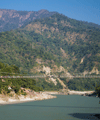February
Water samples from the Upper Ganges River shed light on the spread of potential 'superbugs'

The spread of antibiotic-resistance to one of the most pristine locations in Asia is linked to the annual human pilgrimages to the region, new research has shown.
Experts from Newcastle University, UK, and the Indian Institute of Technology in Delhi (IIT-Delhi), sampled water and sediments at seven sites along the Upper Ganges River, in the foothills of the Himalayas.
They found that in May and June, when hundreds of thousands of visitors travel to Rishikesh and Haridwar to visit sacred sites, levels of resistance genes that lead to "superbugs" were found to be about 60 times greater than other times of the year.
Publishing their findings today in the journal Environmental Science and Technology, the team say it is important to protect people visiting and living at these sites while also making sure nothing interferes with these important religious practices.
They argue that preventing the spread of resistance genes that promote life-threating bacteria could be achieved by improving waste management at key pilgrimage sites.
“This isn’t a local problem – it’s a global one,” explains Professor David Graham, an environmental engineer based at Newcastle University who has spent over ten years studying the environmental transmission of antibiotic resistance around the world.
“We studied pilgrimage areas because we suspected such locations would provide new information about resistance transmission via the environment. And it has – temporary visitors from outside the region overload local waste handling systems, which seasonally reduces water quality at the normally pristine sites.
“The specific resistance gene we studied, called blaNDM-1, causes extreme multi-resistance in many bacteria, therefore we must understand how this gene spreads in the environment.
“If we can stem the spread of such antibiotic resistant genes locally – possibly through improved sanitation and waste treatment - we have a better chance of limiting their spread on larger scales, creating global solutions by solving local problems.”
Funded by the Engineering and Physical Sciences Research Council (EPSRC), the aim of the research was to understand how antibiotic resistance was transmitted due to a specific human activity. Local “hot-spots” of antibiotic resistance exist around the world, particularly densely-populated regions with inconsistent sanitation and poor water quality.
By comparing water quality of the Upper Ganges in February and again in June, the team showed that levels of blaNDM-1 were 20 times higher per capita during the pilgrimage season than at other times.
Monitoring levels of other contaminants in the water, the team showed that overloading of waste treatment facilities was likely to blame and that in many cases, untreated sewage was going straight into the river where the pilgrims bathe.
“The bugs and their genes are carried in people’s guts,” explains Professor Graham. “If untreated wastes get into the water supply, resistance potential in the wastes can pass to the next person and spiralling increases in resistance can occur.”
Concern over the spread of Antibiotic-Resistant (AR) genes
Worldwide, concern is growing over the threat from bacteria that are resistant to the so-called “last resort” class of antibiotics known as Carbapenems, especially if resistance is acquired by aggressive pathogens.
Of particular concern is NDM-1, which is a protein that confers resistance in a range of bacteria. NDM-1 was first identified in New Delhi and coded by the resistant gene blaNDM-1.
Until recently, strains that carry blaNDM-1 were only found in clinical settings, but in 2008, blaNDM-1 positive strains were found in surface waters in Delhi. Since then, blaNDM-1 has been found elsewhere in the world, including new variants.
There are currently few antibiotics to combat bacteria that are resistant to Carbapenems and worldwide spread of blaNDM-1 is a growing concern.
Professor Graham, who is based in the School of Civil Engineering and Geosciences at Newcastle University, UK, said the team had planned to repeat their experiments last year, but the region was hit by massive floods in June and the experiments were abandoned.
The team has since returned to Rishikesh and Haridwar and hope their work will prompt public action to improve local sanitation, protecting these socially important sites. On a global scale, they want policymakers to recognise the importance of clean drinking water in our fight against antibiotic resistance.
“What humans have done by excess use of antibiotics is accelerate the rate of evolution, creating a world of resistant strains that never existed before” explains Graham.
“Through the overuse of antibiotics, contamination of drinking water and other factors, we have exponentially speeded-up the rate at which superbugs might develop.
“For example, when a new drug is developed, natural bacteria can rapidly adapt and become resistant; therefore very few new drugs are in the pipeline because it simply isn’t cost-effective to make them.
“The only way we are going to win this fight is to understand all of the pathways that lead to antibiotic resistance. Clearly, improved antibiotic stewardship in medicine and agriculture is crucial, but understanding how resistance transmission occurs through our water supplies is also critical. We contend that improved waste management and water quality on a global scale is a key step.”
Source information: “Increased waterborne blaNDM-1 resistance gene abundances associated with seasonal human pilgrimages to the Upper Ganges River”. ZS Ahammad, TR Sreekrishnan, CL Hands, CW Knapp and DW Graham. Environmental Science and Technology.
DOI: 10.1021/es405348h
published on: 17 February 2014
